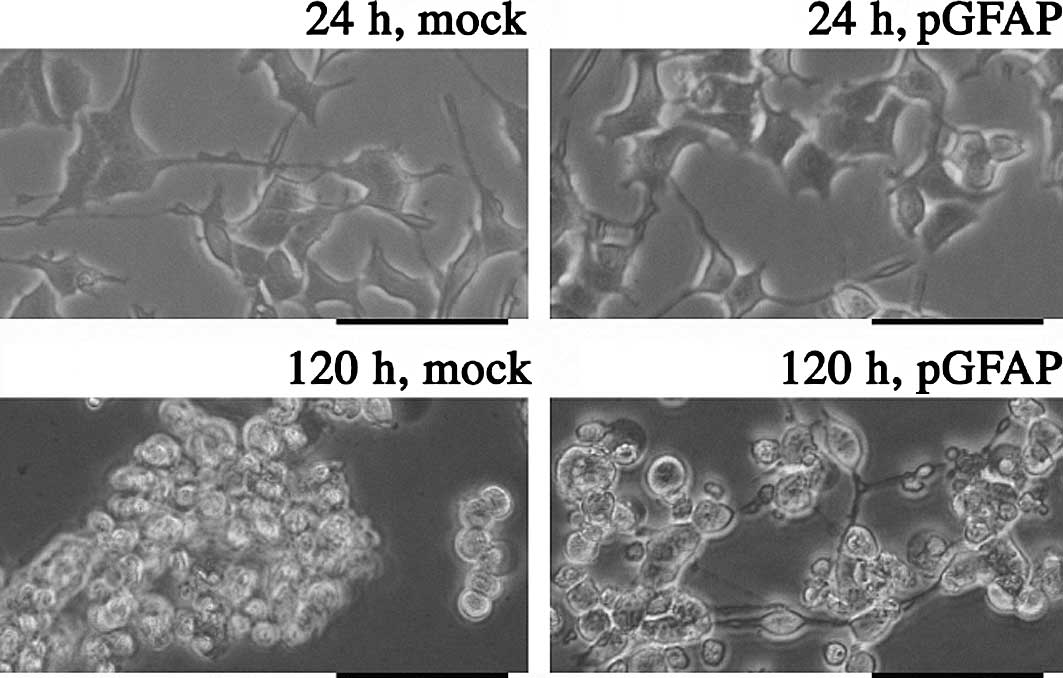|
1.
|
Rodríguez JJ, Olabarria M, Chvatal A and
Verkhratsky A: Astroglia in dementia and Alzheimer's disease. Cell
Death Differ. 16:378–385. 2009.
|
|
2.
|
Bignami A, Eng LF, Dahl D and Uyeda CT:
Localization of the glial fibrillary acidic protein in astrocytes
by immunofluorescence. Brain Res. 43:429–435. 1972. View Article : Google Scholar : PubMed/NCBI
|
|
3.
|
Antanitus DS, Choi BH and Lapham LW:
Immunofluorescence staining of astrocytes in vitro using antiserum
to glial fibrillary acidic protein. Brain Res. 89:363–367. 1975.
View Article : Google Scholar : PubMed/NCBI
|
|
4.
|
Counts SE and Mufson EJ: The role of nerve
growth factor receptors in cholinergic basal forebrain degeneration
in prodromal Alzheimer disease. J Neuropathol Exp Neurol.
64:263–272. 2005.PubMed/NCBI
|
|
5.
|
Angelopoulos P, Agouridaki H, Vaiopoulos
H, et al: Cytokines in Alzheimer's disease and vascular dementia.
Int J Neurosci. 118:1659–1672. 2008.
|
|
6.
|
Eng LF and Ghirnikar RS: GFAP and
astrogliosis. Brain Pathol. 4:229–237. 1994. View Article : Google Scholar : PubMed/NCBI
|
|
7.
|
Mouser PE, Head E, Ha KH and Rohn TT:
Caspase-mediated cleavage of glial fibrillary acidic protein within
degenerating astrocytes of the Alzheimer's disease brain. Am J
Pathol. 168:936–946. 2006.PubMed/NCBI
|
|
8.
|
Quinlan RA, Brenner M, Goldman JE and
Messing A: GFAP and its role in Alexander disease. Exp Cell Res.
313:2077–2087. 2007. View Article : Google Scholar : PubMed/NCBI
|
|
9.
|
Tardy M, Fages C, Le Prince G, Rolland B
and Nunez J: Regulation of the glial fibrillary acidic protein
(GFAP) and of its encoding mRNA in the developing brain and in
cultured astrocytes. Adv Exp Med Biol. 265:41–52. 1990. View Article : Google Scholar : PubMed/NCBI
|
|
10.
|
Lefrançois T, Fages C, Peschanski M and
Tardy M: Neuritic outgrowth associated with astroglial phenotypic
changes induced by antisense glial fibrillary acidic protein (GFAP)
mRNA in injured neuron-astrocyte cocultures. J Neurosci.
17:4121–4128. 1997.
|
|
11.
|
Brenner M, Johnson AB, Boespflug-Tanguy O,
et al: Mutations in GFAP encoding glial fibrillary acidic protein
are associated with Alexander disease. Nat Genet. 27:117–120. 2001.
View Article : Google Scholar : PubMed/NCBI
|
|
12.
|
Goss JR, Finch CE and Morgan DG:
Age-related changes in glial fibrillary acidic protein mRNA in the
mouse brain. Neurobiol Aging. 12:165–170. 1991. View Article : Google Scholar : PubMed/NCBI
|
|
13.
|
Greene LA and Tischler AS: Establishment
of a noradrenergic clonal line of rat adrenal pheochromocytoma
cells which respond to nerve growth factor. Proc Natl Acad Sci USA.
73:2424–2428. 1976. View Article : Google Scholar
|
|
14.
|
Pekny M, Levéen P, Pekna M, et al: Mice
lacking glial fibrillary acidic protein display astrocytes devoid
of intermediate filaments but develop and reproduce normally. EMBO
J. 14:1590–1598. 1995.PubMed/NCBI
|
|
15.
|
Shibuki K, Gomi H, Chen L, et al:
Deficient cerebellar long-term depression impaired eyeblink
conditioning and normal motor coordination in GFAP mutant mice.
Neuron. 16:587–599. 1996. View Article : Google Scholar : PubMed/NCBI
|
|
16.
|
Liedtke W, Edelmann W, Bieri PL, et al:
GFAP is necessary for the integrity of CNS white matter
architecture and long-term maintenance of myelination. Neuron.
17:607–615. 1996. View Article : Google Scholar : PubMed/NCBI
|












